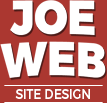What is Good Website Design?

Just like an architect considers the client's needs before designing a functional and appealing home, a good web designer begins by understanding every client's specific requirements and their online visitors' experience. Only then can he or she create a profit-building website that is inviting, cohesive, and user-friendly.
May 2, 2024 • 5 min read
Many small business clients believe that a 'pretty' website and cutting-edge design are critical to attracting visitors and converting them into customers. Studies suggest, however, that what visitors really want are the basics: does the site rank highly in Google, load quickly, display properly on desktop and mobile, and can I easily find what I'm looking for without being assaulted with annoying advertising and popups?
At Joe Web Site Design, our definition of a 'successful website' is one that achieves the site owner's goals (such as increasing company sales) and engages its visitors, encouraging interaction with its content. Ultimately, the site should deliver a positive Return on Investment (ROI) for the site owner.
What Makes a Good Website Design?
The best website design incorporates elements that contribute to success, such as easy-to-navigate menus, fast-loading pages, optimized content, mobile-friendly design, and consistent branding. It also avoids pitfalls like frequent pop-ups, tiny or low-contrast text, long copy blocks, forms with too many required fields, obstructive ads, and lack of a clear and optimized call-to-action.
"When you look at the most popular and profitable websites, rarely are they the most technical or flashy."
Common Mistakes in Website Design
Overemphasis on Visuals
Aesthetics are important, but colors, graphics, pop-ups, and animation should only help communicate the site's primary message. Basics like easy navigation, intuitive design, usability, and functionality are crucial for a site's success.
Mistaking Complexity for Quality
Complex layouts with animations, sliders, and other flashy features can slow down a page and frustrate visitors. Users appreciate simple, fast-loading, and easy-to-use sites.
Ignoring Mobile and Tablet Optimization
With approximately 60% of web traffic coming from phones, it's essential to ensure your site looks good and works well on all devices.
Undervaluing Content
Visual appeal is important, but clear, engaging content in body copy, product details, and descriptions is more likely to convert visitors into customers.
Neglecting SEO and User Experience
Websites that load quickly, are well-organized, are easy to navigate, display well on all devices, contain no broken links, and provide appealing content tend to rank higher in both visitor satisfaction and search engine rankings.
Characteristics of a Well-Designed Website
Clear Goals and Purpose
Define whether your site is meant to share ideas, sell products, drive customers to your showroom, entertain, etc.
Focus on User Experience (UX)
Ensure your site is quick-loading, visually appealing, intuitive to navigate, and accessible on all devices.
-
Engaging Content
Use relevant, cohesive wording, visuals, and videos that speak to your target market, provide needed information, and motivate action.
Consistent Branding and Identity
Ensure your logo, colors, fonts, and messaging work together to establish professionalism, credibility, and trust. (This applies not only to the elements on your site but also to your social media accounts, print advertising, and other marketing materials.)
Incorporate SEO
Good SEO practices should align with a good visitor experience.
Prioritize Loading Speed and Performance
Pages should load within 3 seconds to avoid losing 53% of visitors. Aim for high performance even for users with slow internet access.
7. Measure Website Success
Use analytics and performance metrics to evaluate whether the site is meeting its goals. A website may be attracting traffic but still losing visitors if pricing isn't competitive, products fall short, or customer service is lacking. And if the site isn’t driving traffic at all, it’s important to know that, too. Key metrics include search engine rankings, visitor numbers, time on page, bounce rate, lead generation, and conversions.
While many analytical tools exist -- from heat-mapping to A/B testing to focus groups -- the two most popular, easy to use, and free are Google Analytics and Google Search Console.
Quick Checklist for Evaluating a Website
- Clear and intuitive navigation
- Responsive design
- Fast loading times
- Cohesive and visually appealing design
- Each page's file name, meta title, meta description, schema and OG, and H1 headline are concise and optimized.
- Inviting and readable text
- Accessibility
- Clear call-to-action, as seen in these CTA best examples
- Engaging multimedia. Images are optimized for quality appearance and fast loading
- Optimized for SEO
- Visible and consistent contact information
- Provides methods for tracking key metrics
Conclusion
Good website design goes beyond visual appeal or fancy features. Focus on the site's objectives, the visitors' experience, and achieving meaningful outcomes for both.
Contact Joe Web site design in Asheville
At Joe Web Site Design, we make the web design process easy and stress-free. Our team is friendly, supportive, and dedicated to helping your business succeed online.
To learn more and discuss your website needs and goals, call us today at 828-551-9761.



